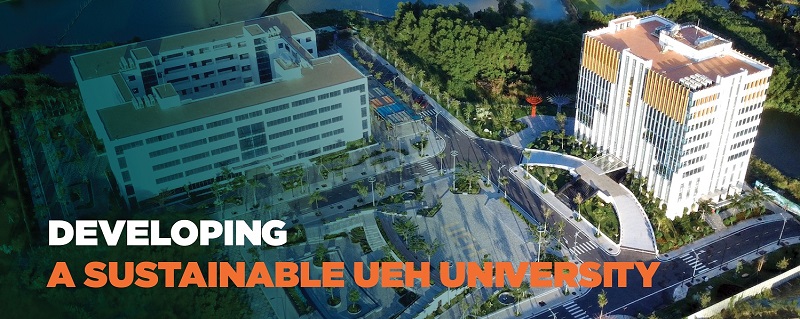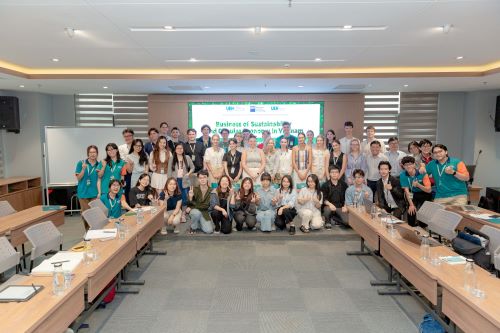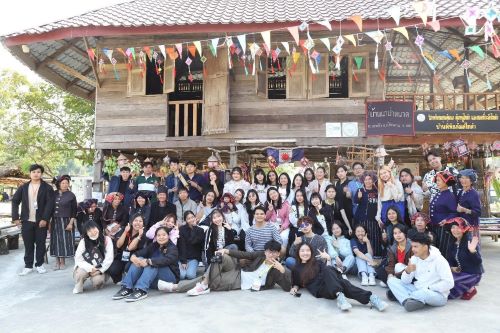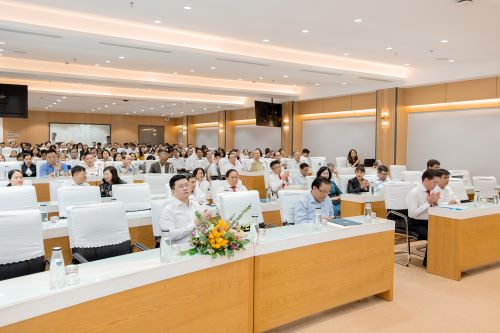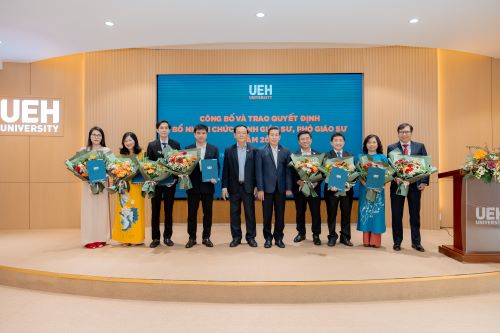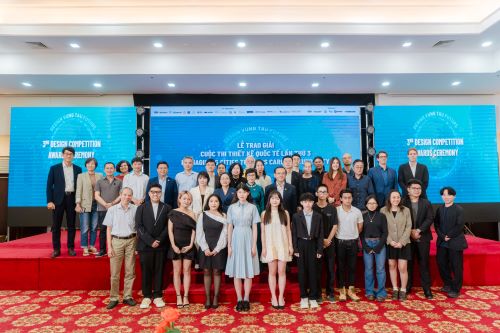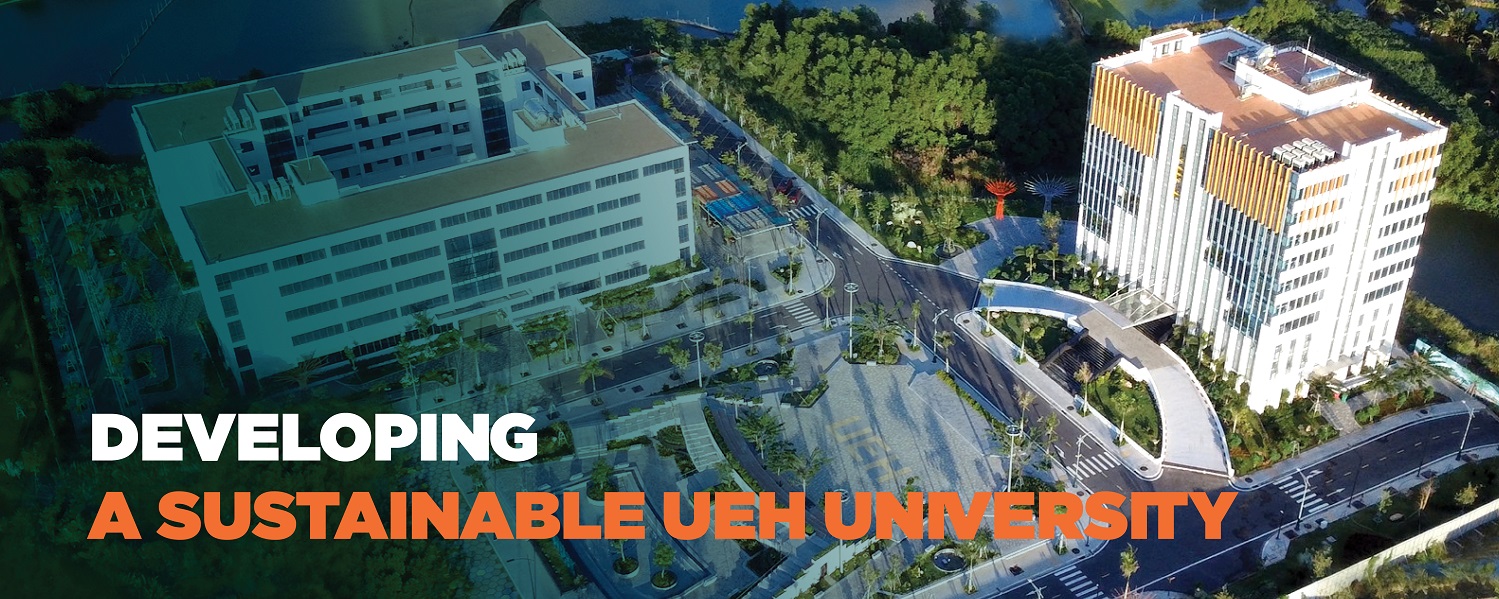
Developing a sustainable UEH University
A variety of questions have been raised when UEH announced ‘UEH Sustainable University Development’ Strategy; listing as: What is ‘sustainable action’ in training, research, operation, administration and community connection? Is building a sustainable university equivalent to implementing only sustainable training and research besides other activities are just as supporting role, or can these activities be implemented separately? How does UEH define a sustainable university development strategy? What role will UEH-affiliated units, individual UEH employee and staff play in this process? Within this article framework, Sustainable University Project Board will concentrate on clarifying the content of a sustainable university and major orientations that UEH will be deploying in the upcoming period.
Sustainable development principles have been applied and implemented in different fields for a long time all over the world: economic sector (UN, 1987), tourism (UNWTO, 2005), energy (UNWTO, 2005), World Energy Council (2018), health (Yélamos et al., 2019) and education for sustainable development (UNESCO, 2019). However, the 2030 Agenda for Sustainable Development, adopted by all United Nations members in 2015 (UN, 2015), offers a common plan for peace and prosperity for all involved and the planet, at present and in future with an emphasis on acknowledging 17 Sustainable Development Goals (SDGs). This recognition as an urgent call to action by all developed and developing countries in a global partnership, in which, the role of universities is very important in promoting and implementing 17 SDGs successfully. Universities do contribute to training and research towards sustainable development, in addition, each university itself must transform into a sustainable university, that is, actively participating in promoting and solving problems at regional or global level; strive to minimize negative economic, environmental, social and health impacts by using resources for teaching and research in ways that assist each society with the transition to sustainable lifestyles. Therefore, in order to fulfill the two central functions of a sustainable university, namely training and research, as well as to promote knowledge transfer and develop tools to realize SDGs or develop integrated projects in combination with other related partners (government, society and private sector), sustainable universities need to develop and integrate three more groups of activities: community, operation and school administration (Jora, 2020; Movement, 2019; UN, 2017; UNESCO, 2019). That is why one prestigious university ranking organization of higher education institutions worldwide (THE), in 2019, has launched Impact Rankings with SDGs integrated ranking criteria as a new approach to promote and recognize university commitment towards achieving the global sustainable development goals. THE Impact Rankings comprise integrated criteria towards sustainability goal.

THE Impact Rankings with integrated criteria towards sustainability goal
UEH, thanks to our pioneering steps and steady development since its establishment in 1976 until now, has proven to be on our right track for sustainable university development through the achievements in training, research, community connection, school operation and administration. It is the year 2021 that marks a major turning point for UEH with our restructuring strategy to become a multidisciplinary and sustainable UEH University (2022-2030 period). UEH, counting from this moment, is both aiming at sustainable development and moving to a new phase: sustainable action in the pillars of training, research, operation, governance and community connection.

A lot of questions have been raised upon UEH announcement regarding UEH sustainable university development strategy: What is ‘sustainable action’ in training, research, operation, administration and community connection? Is building a sustainable university equivalent to implementing only sustainable training and research with support from other activities, or can these activities be performed in separation? How does UEH define a sustainable university development strategy? What role will units, individual employees and employees of UEH play in this process? Within the framework of this article, we will focus on clarifying the content of a sustainable university and major directions that UEH will deploy in the upcoming period.
In terms of approaches from UN (2017) or UNESCO (2019), Sustainable UEH University will be composed of 5 pillars as follows:
– “Training” Pillar: Sustainable UEH University will “train global citizens to act for sustainable development”, training learners not only acknowledge and be aware of SDGs but also transform their work to be better and more sustainable besides understanding the social, economic and environmental impacts on their future careers and professional work. To fulfill this requirement, training programs and products must take "signals and needs from society and community", "global quality, international standards" as the foundation and integrate the sustainable development principles into all training programs and subjects (linked to output standards), extra-curricular programs; empowering learners to actively learn/research/practice on sustainability through interdisciplinary training - multidisciplinary, practical, learner-centered, continuous and lifelong learning. An even more important thing is that, in addition to the main training programs, one sustainable university must also provide (one or more parts) training and retraining programs to update, supplement and spread new knowledge to the community through extensive online/face-to-face courses and other combinations that contribute to continuous and lifelong learning modes.
- "Research" Pillar: Research activity at Sustainable UEH University includes academic research, applied research with "Research for the benefit of the community" goal. Consequently, the research results must apply or suggest implications, policies, solutions to local and global problems, contributing to the sustainable development process, helping everyone in the community and society to get access and use research results with a positive influence on society. Furthermore, the role of “sustainable researchers” at a university is to look at the different SDGs, understand which approaches are more effective and analyze 2030 Agenda implementation to address the issue so as to propose the most reasonable solution and achieve the most goals. Therefore, it is necessary to carry out researches and consultation in the direction of multidisciplinary integration, linking domestic and international research and strengthening cooperation among universities to promote advantages and solve the unequal allocation problem (resources, fields) among universities and research centers for SDGs goal.
It should be stated that “Training” and “Research” are the two most crucial pillars towards sustainable university development. However, construction and operation is not simple and absolutely needs the integrated, complementary and parallel development of all other activities, including those of a university, like: operation, administration and community connection.
- “Operation” Pillar: Referring to promoting university campuses operation by making the most of natural and social resources to reduce waste, energy consumption: using batteries solar, renewable energy, use of good insulation, waste segregation, sustainable procurement policy towards zero footprint or Green Campus. These campuses, in addition to being environmentally friendly, must also be open to the community accessible, traditional labs need to be replaced by a living lab, eco studio-lab system, where all stakeholders, researchers - lecturers - staff and learners together study, research and thoroughly solve problems of the university itself, of enterprises, of state management agencies or the community.
– “Governance” Pillar: UEH and its affiliated units place sustainability as a priority in the overall development strategy, having an operation way in accordance with the status quo, available characteristics with a specialized department responsible for controlling and evaluating the operation process, realizing an effective university governance model, attaching to the market, implementing digital transformation and developing according to sustainability criteria.
– “Community Connection” Pillar: Being the creation of an open community of learners, officials, employees and partners who are willing to change for sustainable development through self-organized community activities. UEH will build the UEHer Community as “a community of art inspirers and changemakers for sustainability”. UEHer community is defined as an open community of people who have been studying, working, teaching, researching, collaborating and collaborating with UEH through proactive empowerment for student groups, extracurricular activities, active employee participation and partners in action for sustainability and artistic inspiration.
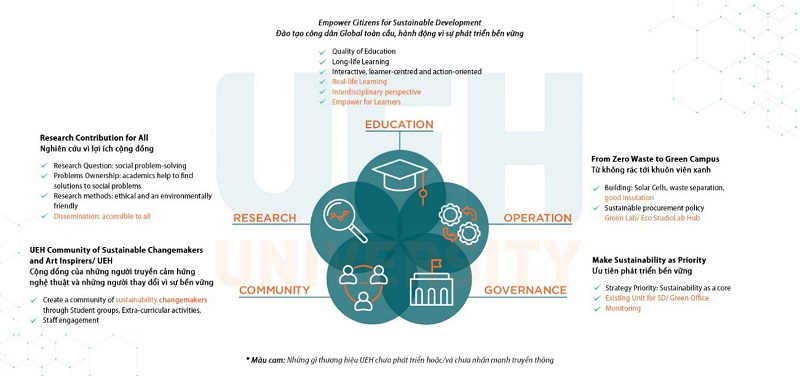
05-pillar model for a multi-disciplinary sustainable UEH University
The reality of implementing sustainable universities around the world shows that it is not possible to develop each of the five activities mentioned above separately or focus only on training and research that other activities only is supplementary. In order to perform any activity, there must be support and impact from other activities and vice versa, neither primary nor secondary. Therefore, UEH needs to develop a framework for sustainable university development that is suitable for the context of each university and Vietnam together with to achieve 17 SDGs with specific quantitative measures (e.g. using assessment criteria) of THE Impact Rankings) on training, research, operation, governance, sustainable community connection activities.
An actual example of how UEH is implementing UEH zero waste (UEHZW) Project associated with building UEH Living lab for training and research. UEHZW Living Lab construction building a zero-waste university campus (2025) as a foundation for a green campus (2030) development and operation in accordance with accreditation criteria of international organizations with reputation like or . UEHZW is not only merely a call to action of learners, lecturers, staff and partners to practice/actively practice zero waste at school or when returning to their place of residence. UEHZW will be a Living lab that includes research and teaching activities that integrate multidisciplinary - interdisciplinary both internal and external partners outside the university, integrating economic-technical-technological factors – society to radically solve the problem of waste (not just on school grounds), incubating new ideas for garbage collection and recycling or developing a circular economy (turning waste into a natural resource), researching models to reduce unnecessary use, changing consumption demand models, investing in financial models in each alternative, developing smart educational platforms or displayed through the content, output standards, practical exercises of each subject, study program and so on.
Restructuring towards becoming a multidisciplinary and sustainable UEH University is a vital decision for UEH and follows the development trend of the times, fulfilling a university responsibility in implementing 17 goals global sustainable development goals. With the pioneering spirit and our own inner strength, the whole UEHers will definitely accompany and actively cope with new challenges to jointly build and develop a sustainable university, contributing to the more prosperous development of a society.
This article is in Series “Developing a sustainable UEH University”, within Sustainable UEH University Project Board.
News, photos: Sustainable UEH University Project Board
